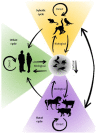Vector-Borne Viral Diseases as a Current Threat for Human and Animal Health-One Health Perspective
- PMID: 35683413
- PMCID: PMC9181581
- DOI: 10.3390/jcm11113026
Vector-Borne Viral Diseases as a Current Threat for Human and Animal Health-One Health Perspective
Abstract
Over the last decades, an increase in the emergence or re-emergence of arthropod-borne viruses has been observed in many regions. Viruses such as dengue, yellow fever, or zika are a threat for millions of people on different continents. On the other hand, some arboviruses are still described as endemic, however, they could become more important in the near future. Additionally, there is a group of arboviruses that, although important for animal breeding, are not a direct threat for human health. Those include, e.g., Schmallenberg, bluetongue, or African swine fever viruses. This review focuses on arboviruses and their major vectors: mosquitoes, ticks, biting midges, and sandflies. We discuss the current knowledge on arbovirus transmission, ecology, and methods of prevention. As arboviruses are a challenge to both human and animal health, successful prevention and control are therefore only possible through a One Health perspective.
Keywords: One Health perspective; arbovirus transmission; arboviruses; arthropod vectors; vaccines.
Conflict of interest statement
The authors declare no conflict of interest.
Figures
References
-
- Esser H.J., Mögling R., Cleton N.B., van der Jeugd H., Sprong H., Stroo A., Koopmans M.P.G., de Boer W.F., Reusken C.B.E.M. Risk Factors Associated with Sustained Circulation of Six Zoonotic Arboviruses: A Systematic Review for Selection of Surveillance Sites in Non-Endemic Areas. Parasites Vectors. 2019;12:265. doi: 10.1186/s13071-019-3515-7. - DOI - PMC - PubMed
-
- Vasilakis N., Gubler D.J. Arboviruses: Molecular Biology, Evolution and Control. Caister Academic Press; Wymondham, UK: 2016.
-
- Karabatsos N. International Catalogue of Arboviruses: Including Certain Other Viruses of Vertebrates. 3rd ed. American Society of Tropical Medicine and Hygiene; San Antonio, TX, USA: 1985. Published for the Subcommittee on Information Exchange of the American Committee on Arthropod-borne Viruses. - PubMed
-
- Arbovirus Catalog—CDC Division of Vector-Borne Diseases (DVBD) [(accessed on 16 February 2022)]; Available online: https://wwwn.cdc.gov/ArboCAT/VirusBrowser.aspx.
Publication types
LinkOut - more resources
Full Text Sources
Research Materials




